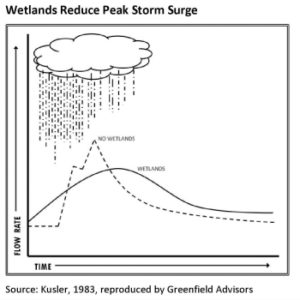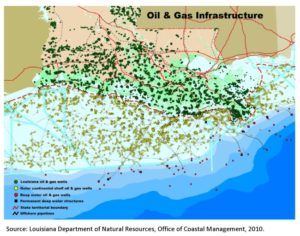This is the third post in a series on the Louisiana coastal wetlands. In the first post, I introduced you to the wetlands and talked about how they formed. In the second post, I discussed some of the reasons they are important, particularly from an ecological perspective, and how the ecological functions of the coastal wetlands affect the economy. In this post, I’ll discuss hydrologic functions, the roles that wetlands play in modifying or controlling the quantity of water moving through an area.

Louisiana’s coastal wetlands provide many essential services to the region and the nation, but perhaps the wetlands’ most important function for the coastal population, and indeed the nation as a whole, is their unique ability to absorb dangerous storm surges from massive Gulf hurricanes. As Kusler demonstrated in 1983 and as seen in the figure below, wetlands play a beneficial role in reducing peak flow rate and storm surge.1 The marshes serve as the first line of defense and a natural buffer to protect Louisiana’s energy infrastructure, ports, and people. We depend on them for their protection of the largest port and commerce infrastructure in the country, as well as the nation’s most concentrated energy infrastructure. The wetlands also serve as the only buffer between millions of coastal residents and the tremendous storm surges brought by the annual hurricanes.
According to the Coalition to Restore Coastal Louisiana, “approximately 2.7 miles of wetlands is capable of absorbing one foot of storm surge.”2 That begs the question of how New Orleans would have fared during Hurricane Katrina if all of Louisiana’s wetlands were still intact. America’s Wetland Foundation explains the situation:
As the protective wetlands and barrier islands of the Gulf Coast degrade, energy, shipping and maritime infrastructure along the coast becomes exposed to open Gulf conditions. Wells, pipelines, ports, roads and levees that are key to energy and commodities delivery become more vulnerable and the potential for damaging oil spills increases. As these conditions worsen, the environmental damage in the event of a hurricane or storm is unthinkable and the nation’s economic and energy security is put at risk; the probability for interruption of oil and gas production and distribution to the nation becomes certain.3
Southern Louisiana is an energy hot spot and has some of the most advanced and concentrated energy infrastructure in the world. The figure below demonstrates the ubiquitous network of wells, refineries, and pipelines covering southern Louisiana. Approximately 25% of all oil and gas consumed in the United States travels through the state via tanker, barge, or pipeline.3 America’s energy coast provides 325,000 jobs and $70 billion annually to the state’s economy.4 According to the Office of Coastal Management citing a Louisiana Department of Natural Resources Technology Assessment Division report, “including Outer Continental Shelf production, Louisiana ranks 1st in crude oil and 1st in natural gas production.”5, 6

A close companion to the region’s energy infrastructure is the massive Mississippi River port system. This port system has five of the fifteen largest ports in the nation, including the top tonnage port in the nation and the largest cargo port complex in the world. Annually, these ports carry more than 450 million tons of cargo, accounting for 18% of the nation’s waterborne commerce. All this commerce generates approximately $35 billion annually—about 13% of the state’s gross domestic product. About $3.8 billion of that amount is accounted for by the 300,000 port- and commerce-related jobs. Not only are one in seven Louisiana jobs dependent on waterways, but 30 other states directly depend on Louisiana’s ports for imports and exports.4
Beyond material and economic benefit, there are the people and communities of the Gulf coast. If wetland degradation and destruction continues, Louisiana’s two million coastal residents will be exposed to more frequent and more severe flooding. Hurricanes and their associated storm surge will continue to devastate New Orleans and many other smaller and less well protected coastal towns.
Louisiana’s wetlands provide an extensive array of services to numerous markets both regionally and nationally. It is indeed “one of the Nation’s most productive natural assets. The region is both a sanctuary and workhorse.”3 As wetland destruction continues and flooding becomes more frequent and more severe, uncertainty and volatility grow and jeopardize any long-term investments in southern Louisiana. Considering the far-reaching influence of Louisiana’s coastal wetlands, it is easy to see how a local crisis can become a national problem.
I will be discussing this problem further in the next post in this series.
– Jonathan Putman






Recent Comments